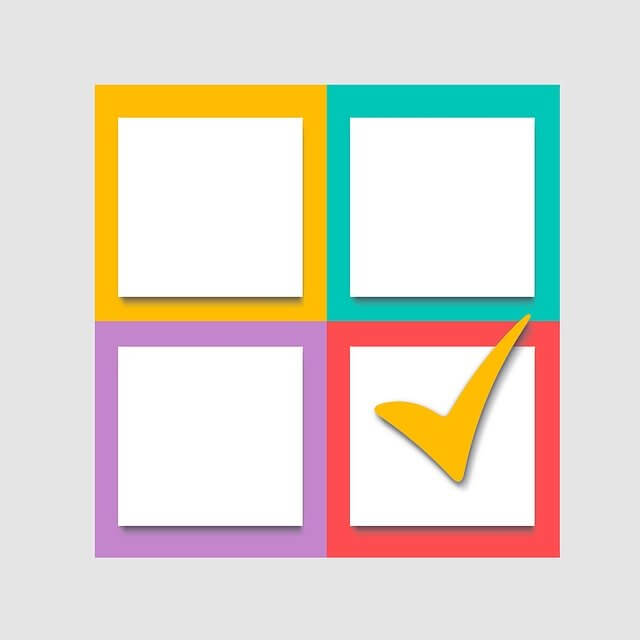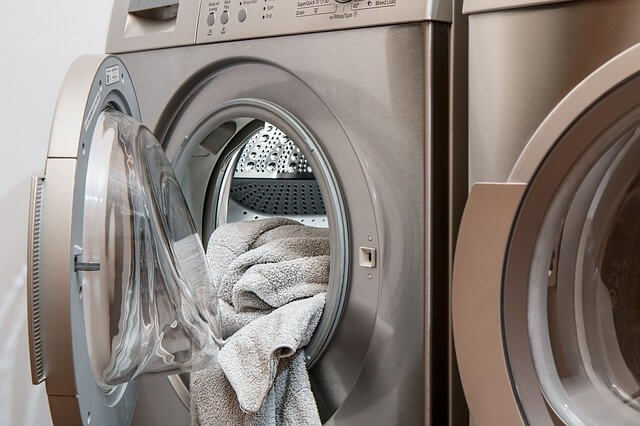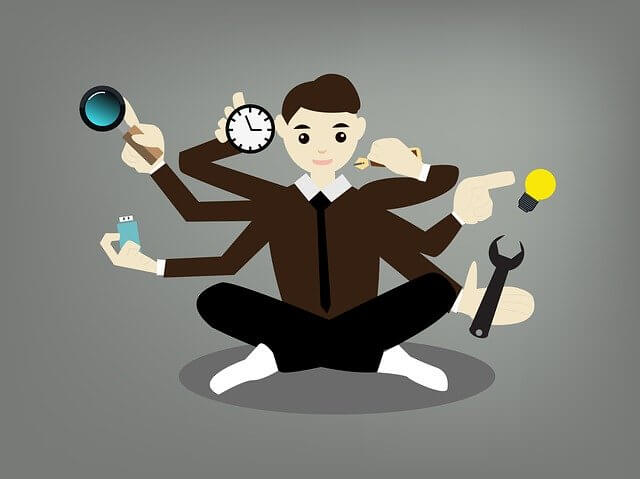How can you be more productive? Maybe you’re already a powerhouse of productivity?
Or maybe you’re a “regular” person with good days and bad days.
You probably start each day with a plan. At least a few tasks that you need (or at least, want) to complete.
You might even maintain an actual todo list.
But then, somehow, the end of the day arrives. What happened to those tasks?
Dilemma
Some people seem to be natural organizers. And others are more… dynamic. 😉
You might hear comments about personality types, temperaments, detail-oriented vs. creative. This seems to imply that some people are naturally more productive than others.
I don’t like to pigeon-hole. Human beings are complex and we have a lot of traits that evolve over time. Let’s not limit ourselves with labels.
But we SHOULD take advantage of our natural tendencies. We can improve our weaker areas over time. But even more importantly, we can leverage our strengths.
How do we do this? How do we become more productive?
Productivity Challenges
Before you can improve, you need to understand where to focus. What are the issues? How does time evaporate on you?
Let’s look at the biggest challenges for most of us throughout the day.
Task Prioritization
How you prioritize your tasks might be sabotaging your results.
Let’s consider a typical day. You’ll have a number of tasks on your list. Some are short and quick while others are longer and require more focus.
What’s your approach? There are typically three (3) choices:
- Focus – do the longer tasks, the tasks that require more focus, first
- Quick – do the short and quick tasks first
- Random – do whatever appears first on the list or pick a task at random
But there’s a more important question here – what is your objective? What’s your longer-term goal? Ask yourself:
- Does the task you’re doing contribute to your bigger picture?
- Will that task matter a few years from now?
You need to prioritize your tasks based on what is more important. That’s the ONLY criteria.
Let’s look at some examples applied to real life.
1. Office environment
A. Business owner/Entrepreneur
Your primary objectives will focus mainly on running/growing/improving your business. But you’ll have many tasks throughout the day. Let’s say your schedule for the day is something like:
- 9:00 Meeting with sales reps
- 11:00 Review/respond to email
- 12:00 Lunch with potential new client
- 14:00 Evaluate new product line
- 16:00 Meeting with line managers
How do you prioritize this list? Isn’t everything equally important?
All of the tasks are important but adjustments can be made. Why does the meeting with the sales reps need to be so long? Could you meet with each of them individually for a few minutes instead?
Could you combine your line managers’ meeting with the evaluation of the new product line?
What’s important here is to assess the reasons behind the tasks. Don’t hold meetings when it’s unnecessary. Try to maximize your efficiency.
B. Corporate Employee
Your primary objectives will focus mainly on completing projects and furthering your career. The first thing you usually do each morning is respond to all email since your previous login.
Does responding to your email contribute to your primary objective? It’s tricky – you might say it depends on whether there’s an urgent email.
So change your approach. Perform a QUICK browse of your email for anything urgent. Then focus your attention on project work first. That’s your priority.
2. Stay-at-home Parent
Your primary objective is to raise your children to be self-reliant adults making a positive contribution to society. Your task list for the day includes: making breakfast, getting the kids off to school, doing laundry, ironing clothes, library reading program with your toddler, cleaning the bathrooms, vacuuming the home, baking cupcakes for the school bake sale, repairing buttons on your child’s favourite shirt, making dinner, etc.
You get it – the list is long. How do you prioritize all of that?!?! First, decide which is more important to you:
- Spending time with your children/how they feel
- How your home looks
- Your societal contributions
It might look like I’m leading you to a specific answer, but I’m not. Everyone has a different perspective.
You might focus on your home for health reasons. If your children have allergies or immune issues then doing laundry more frequently, keeping the bathrooms super clean, and vacuuming the home for allergens could be your primary focus.
Perhaps you want your children to understand the importance of contributing to society. Then your focus might be on getting the kids off to school, library reading program with your toddler, and baking cupcakes for the school bake sale.
Or your kids are at an age where you want to spend more time with them personally. So you concentrate on making them breakfast, getting them off to school, sharing a library reading program experience with your toddler, baking cupcakes (with them) for the school bake sale, and showing your child how you repair the buttons on their favourite shirt.
The point is to prioritize your most important long-term objective. Because you simply can’t do everything!
Task Work Effort Estimation
As you work on prioritizing your task list, you also have to consider the work effort to complete those tasks. Human beings are notoriously poor at predicting how long a task will take.
We see this every day in construction projects: buildings, highways, bridges. Everything takes longer than we expect.
So here’s my own personal rule-of-thumb:
- For a task you’ve done before, MORE than 20 times, then use your first guess estimate as it should be pretty accurate
- If you’ve done a task before but less than 3 times, add some buffer to your estimate (go with, at least, 1.5 times the amount you predict)
- If you’ve never done the task before, then you need to quadruple your estimate at a minimum (maybe even 20 times your estimate depending on the task complexity)
You might balk at that last suggestion for estimating. But you’ll feel much better if you finish a task in less time than if it takes you longer. 😎
Focus Distractions
Perhaps the biggest challenge we have is distractions. These are the ultimate time wasters. The most likely culprits:
- Social media – there are so many social media channels that it’s very easy to get swept away
- Web surfing – even just a quick validation check on the internet and you could head down the rabbit hole
- YouTube – similar to web surfing, it’s super easy to lose track of time here
- Email – we receive so much email that it’s quite difficult to reach an empty inbox (and trying to can take forever)
- Messaging/Texting – whether it’s straight-up texting or WhatsApp or Slack or something similar
- Co-workers – if you’re in an office environment then chatting with your co-workers can seriously reduce your focus
- TV – it’s very easy to just sit and be entertained and NOT focus on your work
Solutions to be More Productive
You’ve read about a number of time wasters. How do you overcome them? What techniques will help you be more productive?
Be ruthless with yourself
With so much potential for distraction, what do you do? Technically, it’s simple – shut them down!
If your computer is the primary point of communication then just shut down those applications: social media, YouTube, and any messaging software.
If you use messaging software to communicate with work colleagues then provide boundaries. Let them know your blackout times – the time frame in which you will not respond to messages. And then… do NOT break your own rules.
The same goes for texting. Let your family and friends know your blackout times. You can still check for emergencies, just don’t respond if they’re not emergencies.
Web surfing and email present additional issues. Especially if you’re in an office environment. It’s difficult to avoid the internet and people often expect quick responses to email.
With email, again try to level-set expectations. Identify specific time slots in which you intend to check your email. Outside of those times, close the application. That’s the best way to avoid the temptation.
With web surfing and co-worker distractions you’ll need to exercise some willpower. This is especially challenging with co-workers as you might find their questions/comments quite interesting. If your situation permits, put on the headphones!
If you have an office, then consider closing the door. But communicate your blackout times so co-workers understand. You want engagement with them but also time to concentrate.
You also need to evaluate yourself. What are your own specific triggers? You need to understand them before you can address them and avoid them.
Try the time blocking technique
Maybe you need to try a completely different strategy. If your current approach isn’t working, you could try time blocking.
Time blocking involves planning out your entire day in advance. You block off times for each and every task.
Some people love this method while others struggle to stick to the plan. You can read more in my article, How Could Time-Blocking Work For You?
Prioritize by activity, not tasks
Have you heard of the book, “The 7 Habits of Highly Effective People?” This book was originally published in 1989 by Stephen Covey.
Based on the Eisenhower Matrix, he outlined four quadrants to help clarify where to focus at any specific moment. The goal is to focus on only those things that matter most – in that moment.
Every task you need to perform gets categorized by a higher-level activity. And that activity is mapped to the matrix. You work on the Urgent and Important items first.
So quadrant 1 receives the most attention immediately. But quadrant 2 needs planning as well.
Work with your energy levels
When are your decision making skills better? At what time of day do you focus better on detailed tasks?
Schedule your day so that you take advantage of your own peak times. You want to work on the most important tasks when your mind is functioning best.
That’s when you’ll have the most energy. And that’s when you’ll be able to complete tasks faster.
If you’re not sure when your energy levels are highest:
- Ask a friend or co-worker – it’s quite likely those around you have noticed when you’re at peak efficiency, even if you haven’t 😀
- Trial and error – over a few weeks, switch the timing of when you work on complex tasks. You’ll begin to see a pattern and then you can modify your approach.
Don’t multitask
“Must excel at multi-tasking.” You probably recognize this as a leading requirement in most job posts. But it’s a myth. Our minds simply don’t function that way.
You lose a lot of time in context switching – switching from one task to another. It takes time to review the task, remember what you’ve already completed, pick up the flow of what’s required next. That’s wasted time.
Your time is much better spent, and far more productive, if you focus on one task at a time. Start a task, complete the task, and then move on to the next one.
This ensures you don’t spend time reviewing multiple times. I call this the “one touch” policy. If you’re going to look at it, then just finish it.
Take breaks
This might seem counter-intuitive. But extended periods of concentration can be difficult. So you need to incorporate breaks into your work:
- Physical movement – go for a walk, run up some stairs… do something physically stimulating
- Get outside – a quick connection with nature is reviving
- Socialize – have a quick chat with a friend or co-worker
If possible, combine ALL of the above. Go for a walk outside with a friend!
Any of the activities above will help you to re-focus. You’ll feel refreshed and invigorated, ready to focus on your tasks.
Just be mindful that it’s a break. Too much time and it becomes just another time waster.
Adjust your mindset
Consider your own internal dialogue. Are you subconsciously sabotaging your efforts?
Think of the 80/20 rule – also known as the Pareto principle. Basically, 20% of your work accounts for 80% of the results. It’s all about cause and effect and there are many examples online:
Your internal dialogue plays a part here. If you constantly think about how you can’t – can’t finish, can’t achieve – then you won’t.
Whenever you find yourself thinking “I can’t”, change that to “How can I…” This reshapes your tasks to focus on what you can complete.
Yup – I went all philosophical there. But it works! Try it.
Evaluation and Acceptance
So what’s the take away?
It’s all about you! You have to find what works for you. But this article gives you some solid ideas and a variety of places to start.
Take into consideration your own personality type before you decide on your approach. Think about your energy levels – when are you at peak efficiency?
Try some of the prioritization techniques. Choose the tasks that matter most and do them first. Work on the more complex tasks when your energy level is high. Learn how to ignore the tasks that don’t matter for your long-term goals.
Practice estimating the work-effort required for different tasks. Address your distractions:
- Close apps
- Turn off the TV
- Put your smartphone on silent
- Get out those headphones
And accept yourself. Some days, nothing will work. We all have those days. You can’t change the past so just focus on how you’ll do better next time.
Enable your own support system. Get enough sleep, exercise regularly, and don’t ignore nutrition.
Break those tasks into smaller chunks. Start crossing off those finished items – that’s another dopamine rush all by itself!
You’ll be more productive in no time.
Like This Post? Put a Pin On It!
Did you find this article useful and helpful?
Share this WOWIT post on social media!
Have some suggestions of your own?
Click the Submit Comment button below to let us know!
Want More?
Would you like to learn more about this topic? Or perhaps explore some other topics? Choose from one of the categories below to see more:
Subscribe to our newsletter to have information delivered right to your inbox.






















